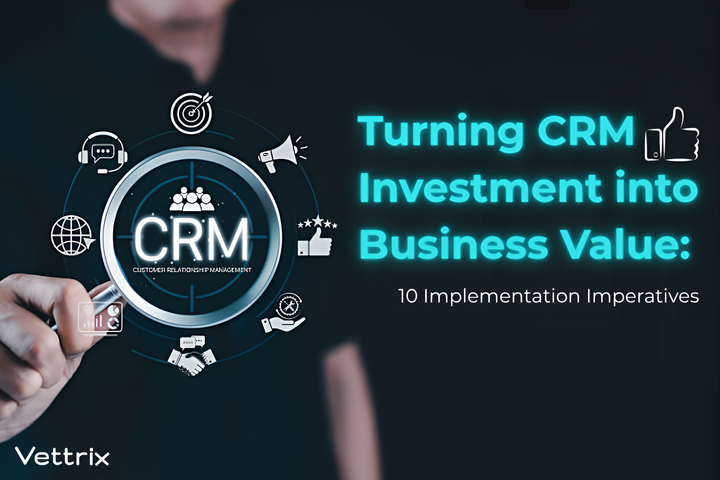Turning CRM Investment into Business Value: 10 Implementation Imperatives

Implementing a Customer Relationship Management (CRM) system like Vettrix is a transformative initiative that can dramatically improve how your organization manages customer relationships and drives growth. However, success depends on careful planning and execution. Here are the essential factors to keep in mind during your CRM implementation journey:
1. Define Clear Business Objectives
Before selecting any features or beginning configuration, establish precisely what you want to achieve:
- Identify specific, measurable goals (e.g., "Increase lead conversion by 25%" or "Reduce customer service response time by 40%")
- Align CRM objectives with broader organizational strategy
- Prioritize objectives based on business impact and urgency
- Create a roadmap that outlines when different objectives will be addressed
Key Consideration: Avoid the common pitfall of implementing CRM technology without clear business drivers. Every configuration decision should support specific business outcomes.
2. Secure Executive Sponsorship and Stakeholder Buy-in
CRM implementation is a business initiative, not just an IT project:
- Identify an executive sponsor who will champion the project
- Involve key stakeholders from all affected departments early in the process
- Communicate the "why" behind the implementation, not just the "what" and "how"
- Address concerns and resistance proactively through open communication
Key Consideration: Without visible leadership support, CRM initiatives often struggle with adoption and resource allocation. Executive sponsors should actively participate in key meetings and communications.
3. Map and Optimize Business Processes
CRM implementation offers an opportunity to improve how you work:
- Document current processes before configuring the system
- Identify inefficiencies and pain points in existing workflows
- Redesign processes to leverage CRM capabilities rather than simply digitizing broken processes
- Create visual process maps to guide configuration decisions
Key Consideration: Resist the temptation to replicate existing processes exactly as they are. The implementation is an opportunity to eliminate unnecessary steps and improve efficiency.
4. Prioritize Data Quality and Migration Strategy
Your CRM is only as good as the data it contains:
- Clean and deduplicate existing data before migration
- Establish data governance standards and ownership
- Implement validation rules to maintain data quality
- Consider a phased migration approach rather than moving all data at once
Key Consideration: Poor data quality is one of the leading causes of CRM failure. Invest time in data preparation before migration to avoid compounding existing problems.
5. Design for User Adoption
The most sophisticated CRM will fail if people don't use it:
- Involve end users in the design process
- Prioritize intuitive interfaces and simplified workflows
- Focus on features that deliver immediate value to users
- Minimize required clicks and data entry where possible
Key Consideration: Design your CRM with the user experience as a primary consideration, not just technical capabilities. Shadow users to understand their daily challenges and needs.
6. Develop a Comprehensive Training Strategy
Different users have different learning needs:
- Create role-specific training programs
- Offer multiple learning formats (hands-on workshops, videos, documentation)
- Schedule training close to go-live to maximize retention
- Identify and train system champions who can provide peer support
Key Consideration: Training should focus not just on how to use the system but on why it matters to users' daily work and how it will make their jobs easier.
7. Plan for Integration with Existing Systems
Your CRM doesn't exist in isolation:
- Identify all systems that need to connect with your CRM
- Determine data flow requirements between systems
- Establish integration priorities based on business impact
- Consider API limitations and technical requirements early
Key Consideration: Integration complexity is often underestimated. Involve IT early and consider starting with the most critical integrations rather than attempting to connect everything at once.
8. Implement in Phases
Trying to do everything at once increases risk:
- Start with core functionality that delivers immediate value
- Consider a pilot approach with a smaller user group
- Allow time between phases to incorporate learnings
- Celebrate quick wins to build momentum
Key Consideration: A phased approach reduces risk and allows the organization to adapt to change more effectively. Begin with high-impact, lower-complexity components.
9. Establish Clear Metrics and Reporting
You can't improve what you don't measure:
- Define key performance indicators (KPIs) for your CRM implementation
- Create dashboards that provide visibility into these metrics
- Schedule regular reviews of system usage and business impact
- Use data to identify adoption challenges and success stories
Key Consideration: Align CRM metrics with the business objectives established at the outset. Measure both system adoption and business outcomes.
10. Create a Governance and Continuous Improvement Framework
CRM implementation is an ongoing journey:
- Establish a governance committee with cross-functional representation
- Create clear processes for system changes and enhancements
- Schedule regular system reviews and optimization sessions
- Stay current with CRM updates and new features
Key Consideration: Without proper governance, CRM systems often experience "drift" over time, with inconsistent practices and declining data quality. A formal governance structure prevents this deterioration.
Conclusion: Success Requires Balance
Successful CRM implementation requires balancing technology, processes, and people. By keeping these ten factors in mind, you'll significantly increase your chances of a successful deployment that delivers lasting business value.
Remember that CRM implementation is not a one-time project but an ongoing program that evolves with your business. The most successful organizations view their CRM as a strategic asset that requires continuous investment and optimization.
"The companies that extract the most value from CRM are those that use it not just to record what happened, but to influence what will happen next."